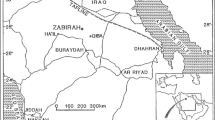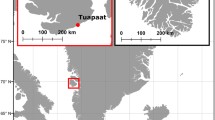Abstract
The ground-penetrating radar (GPR) was used to trace the subsurface details in the Palshet coastal zone (Maharashtra) as it exhibits an interesting array of geomorphological features. Furthermore, our main goal was to identify and locate features that might have formed during a reported extreme event and its effects on the flow of the nearby Sundri River. Two profiles (8 and 4 m depth) were collected across the beach and along the backshore, respectively. While the 8-m depth profile (west to east; across the beach) indicates a series of coastline regression in this area, the 4-m depth profile along the coastline (north to south) in the backshore zone reveals two significant incidents viz., (1) stages of development of the paleo-channels that indicate the migration of the Sundri River towards south and (2) huge sediment deposits up to 2.5-m thick in the backshore area. The erosional relict surface (~2.5 m depth) was traced along with various spells of sediments that perhaps occurred due to an extreme event. Sand samples were collected from two trial pits along the GPR profiles to understand the sedimentology and mineralogy in the backshore area. These data together with beach profiles and geomorphological maps suggest that the sands were deposited by an extreme event perhaps during the 1854 cyclonic storm. The sands were trapped in suitable geomorphological sites along the Palshet coast and these sand deposits of about 2.5 m thickness forced the River Sundri to shift its course towards the south. This new revelation facilitates a further study that could focus on the nearby coastal areas to document such extreme event deposits and their influence on the geomorphic set-up.









Similar content being viewed by others
References
Altdorff D, Epting J, Kruk J, Dietrich P, Huggenberger P (2013) Delineation of fluvial sediment architecture of subalpine riverine systems using noninvasive hydrogeophysical methods. Environ Earth Sci 69(2):633–644
Clemmensen LB, Nielsen L (2010) Internal architecture of a raised beach ridge system (Anholt, Denmark) resolved by ground-penetrating radar investigations. Sediment Geol 223(3–4):281–290
Daniels DJ (2007) Ground penetrating radar, 2nd edn. The Institution of Engineering and Technology, London
Dougherty AJ, FitzGerald DM, Buynevich IV (2004) Evidences for storm-dominated early progradation of Castle Neck barrier, Massachusetts, USA. Mar Geol 210:123–134
Dube SK, Rao AD, Sinha PC, Murty TS, Bahulayan N (1997) Storm surge in the Bay of Bengal and Arabian Sea: the problem and its prediction. Mausam 48(2):283–304
Evan AT, Camargo SJ (2011) A climatology of Arabian sea cyclonic storms. J Clim 24(1):140–158
Gourry J-Ch, Vermeersch F, Garcin M, Giot D (2003) Contribution of geophysics to the study of alluvial deposits: a case study in the Val d’Avaray area of the river Loire, France. J Appl Geophys 54(1–2):35–49. doi:10.1016/j.jappgeo.2003.07.002
Jones HL, Hajek EA (2007) Characterizing avulsion stratigraphy in ancient alluvial deposits. Sediment Geol 2001(1–2):124–137. doi:10.1016/j.sedgeo.2007.02.003
Kortekaas S, Dawson AG (2007) Distinguishing tsunami and storm deposits: an example from Martinhal, SW Portugal. Sediment Geol 200:208–221. doi:10.1016/j.sedgeo.2007.01.004
Koster B (2012) Ground penetrating radar (GPR) investigations on tsunamigenic deposits: examples from southern Spain and Greece. Quat Int 279–280(16):254
Kraus MJ, Wells TM (1999) Recognizing avulsion deposits in the ancient stratigraphical record. In: Smith ND, Rogers J (ed) Fluvial sedimentology VI, Special Publication of the International Association of Sedimentologists, vol 28, pp 251–268
Loveson VJ, Gujar AR (2010) High resolution mapping, modeling and evolution of sub-surface geomorphology using ground penetrating radar techniques. In: Anbhazagan S, Subramanian SK, Yang (eds) Applied geomatics in Geomorphology. Taylor & Francis, London, pp 119–139
Loveson VJ, Barnwal RP, Singh VK, Gujar AR, Rajamanickam GV (2005) Application of ground penetrating radar in placer mineral exploration for mapping subsurface sand layers: a case study. In: Loveson VJ, Chandrasekar N, Sinha A (eds) Developmental planning of placer minerals. Allied Publications, New Delhi, pp 71–79
Maksim B, Marquis G, Nivière B, Maurin JC, Cushing M (2000) Investigating alluvial and tectonic features with ground-penetrating radar and analyzing diffractions patterns. J Geophys 43(1):33–41. doi:10.1016/S0926-9851(99)00031-2
Morton RA, Gelfenbaum G, Jaffe BE (2007) Physical criteria for distinguishing sandy tsunami and storm deposits using modern examples. Sediment Geol 200(3–4):184–207
Murray AS, Svendsen JI, Manqerud J, Astakhoy YI (2007) Testing the accuracy of quartz OSL dating using knowledge Eemian site on the river Sula, northern Russia. Quat Geochronol 2:102–109
Murty TS, El-Sabh MI (1984) Cyclones and storm surges in the Arabian Sea: a brief review. Deep Sea Res Part A Oceanogr Res Papers 31(6–8):665–670
Neal A, Pontee NI, Pye K, Richards J (2002) Internal structure of mixed-sand-and-gravel beach deposits revealed using ground-penetrating radar. Sedimentology 49(4):789–804. doi:10.1046/j.1365-3091.2002.00468.x
Patidar AK, Maurya DM, Thakkar MG, Chamyal LS (2007) Fluvial geomorphology and neotectonic activity based on field and GPR data, Katrol hill range, Kachchh, Western India. Quat Int 159(1):74–92. doi:10.1016/j.quaint.2006.08.013
Pedgley DE (2012) Cyclones along the Arabian coast. Weather. 24(11):456–470. doi:10.1002/j.1477-8696.1969.tb03121.x
Rajeevan M, Srinivasan J, Niranjan Kumar K, Gnanaseelan C, Ali MM (2013) On the epochal variation of intensity of tropical cyclones in the Arabian sea. Atmos Sci Lett 14(4):249–255
Shukla SB (2012) Ground penetrating radar (GPR) studies along the SW Kachchh coast, Western India: implications in reconstructing high energy event history. Quat Int 279–280(16):447
Slingerland R, Smith ND (2004) River avulsions and their deposits. Annu Rev Earth Pl Sc 32(1):257–285. doi:10.1146/annurev.earth.32.101802.120201
Słowik M (2011) Changes of river bed pattern and traces of anthropogenic intervention: the example of using GPR method (the Obra River, western Poland). Appl Geogr 31(2):784–799
Słowik M (2012) Influence of measurement conditions on depth range and resolution of GPR images: the example of lowland valley alluvial fill (the Obra River, Poland). J Appl Geophys 85:1–14. doi:10.1016/j.jappgeo.2012.06.007
Słowik M (2013) GPR and aerial imageries to identify the recent historical course of the Obra River and spatial extent of Obrzańskie Lake, altered by hydro-technical works. Environ Earth Sci. doi:10.1007/s12665-012-2215-9
Smith GHS, Ashworth PJ, Best JL, Woodward J, Simpson CJ (2006) The sedimentology and alluvial architecture of the sandy braided South Saskatchewan River, Canada. Sedimentology 53(2):413–434. doi:10.1111/j.1365-3091.2005.00769.x
Smith GHS, Ashworth PJ, Best JL, Lunt IA, Orfeo O, Parsons DR (2009) The sedimentology and alluvial architecture of a large braid bar, Rio Parana, Argentina. J Sediment Res. 79(8):629–642. doi:10.2110/jsr.2009.066
Sridhar A, Patidar A (2005) Ground penetrating radar studies of a point bar in the Mahi River basin, Gujarat. Curr Sci Ind 89:183–189
Tamura T, Murakami F, Nanayama F, Watanabe K, Saito Y (2008) Ground-penetrating radar profiles of Holocene raised-beach deposits in the Kujukuri strand plain, Pacific coast of eastern Japan. Mar Geol 248(1–2):11–27
Unnikrishnan AS, Kumar M, Ramesh R, Sindhu B (2011) Tropical cyclones in the Bay of Bengal and extreme-sea level projections along the east coast of India in a future climate scenario. Curr Sci India 101:327–331
Vandenberghe J, van Overmeeren RA (1999) Ground penetrating radar images of selected fluvial deposits in the Netherlands. Sediment Geol 128:245–270
Vijaya Lakshmi CS, Srinivasan P, Murthy SGN, Trivedi D, Nair R (2010) Granularity and textural analysis as a proxy for extreme wave events in southeast coast of India. J Earth Syst Sci 119(3):297–305. doi:10.1007/s12040-010-0023-8
Acknowledgments
The financial support from the Council of Scientific & Industrial Research, New Delhi through the Network Project (CMM 0023) is gratefully acknowledged. We thank the Directors of CSIR-CIMFR, CSIR-NIO and WIHG for permission to publish this paper. We appreciate the help rendered by Ms. Ruenna D’Souza and Ms. Dashimi Chari for analyzing the samples and secretarial assistance. We are grateful for the comments and suggestions by the reviewers which helped to revise the manuscript. We thank Professor Olaf Kolditz and Dr. Gunter Doerhoefer, Editor-in-Chief for encouraging us to submit the revised version of the manuscript.
Author information
Authors and Affiliations
Corresponding author
Rights and permissions
About this article
Cite this article
Loveson, V.J., Gujar, A.R., Iyer, S.D. et al. Indications of an extreme event deposits along the west coast of India: evidences from GPR investigations. Environ Earth Sci 72, 4155–4166 (2014). https://doi.org/10.1007/s12665-014-3311-9
Received:
Accepted:
Published:
Issue Date:
DOI: https://doi.org/10.1007/s12665-014-3311-9




